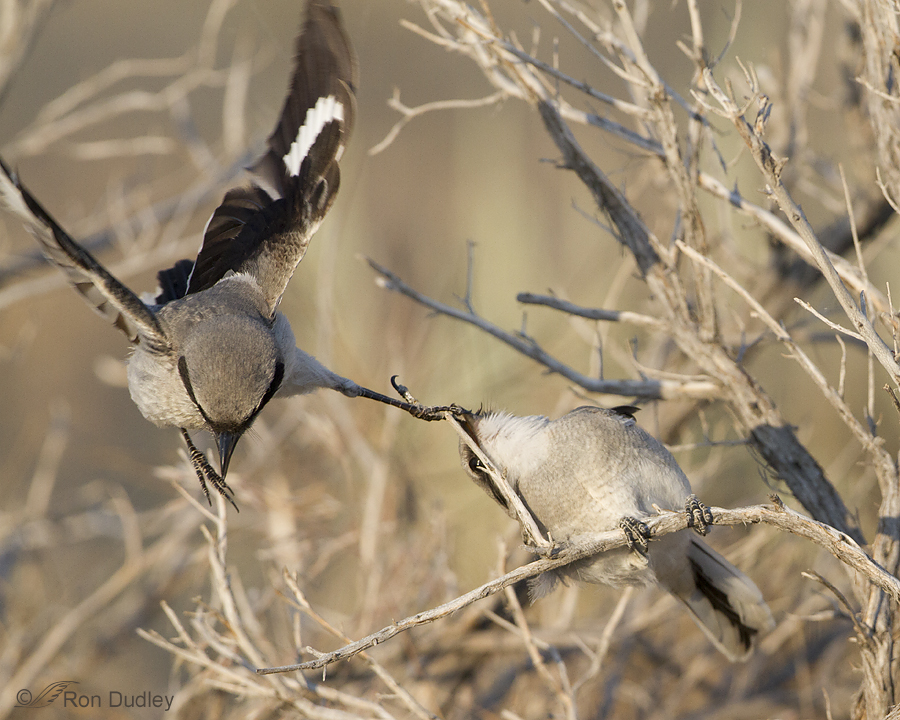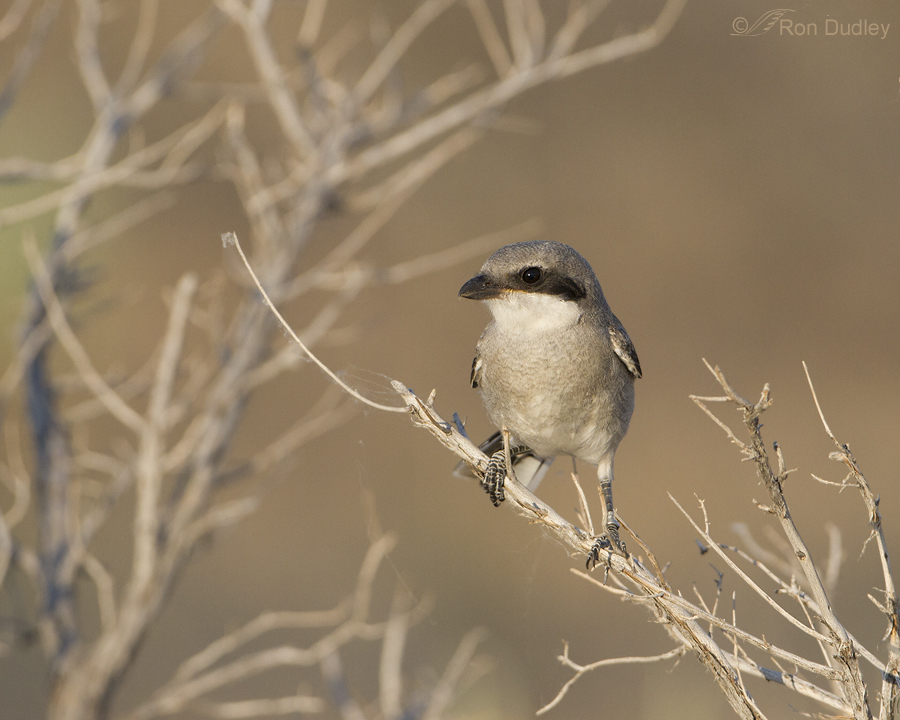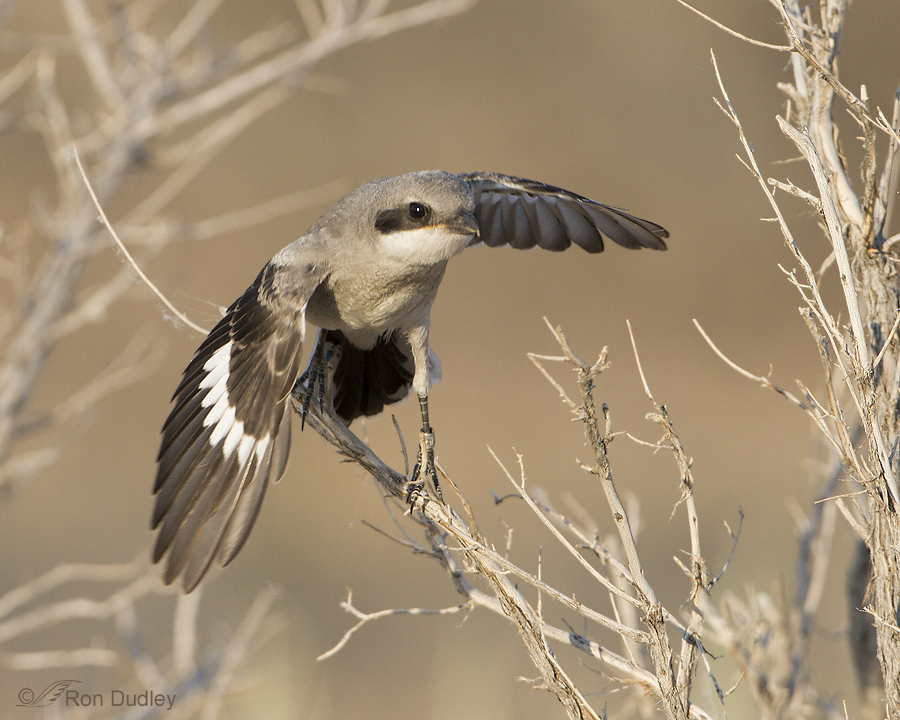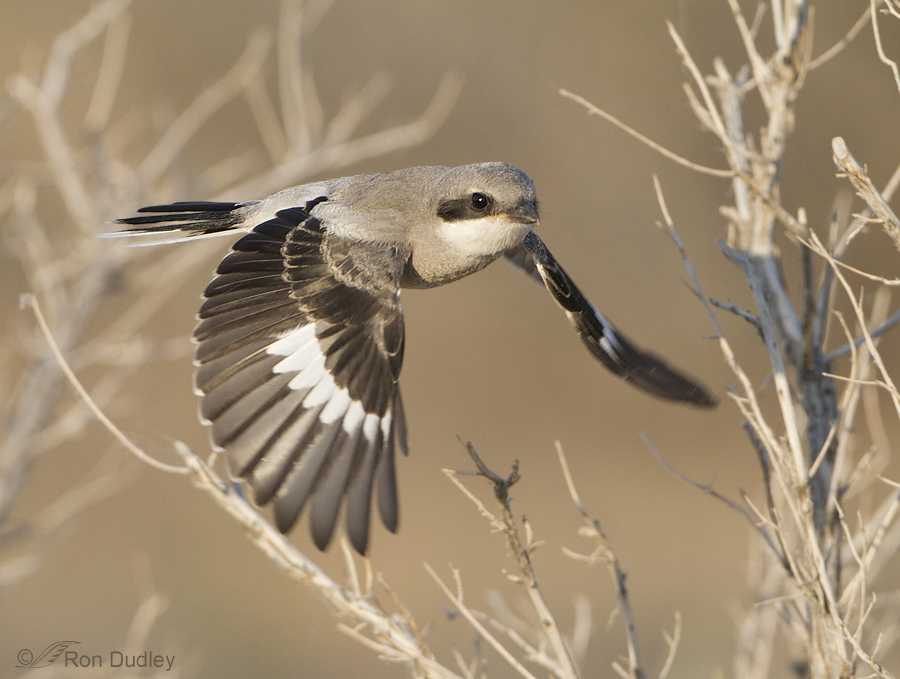Many of the young Loggerhead Shrikes on Antelope Island have now fledged and are in the midst of learning the ropes. They’re ornery, fun, fierce and fearless. Twice I’ve had one almost fly into my open pickup window, another one very nearly landed on my lens hood sticking out a window and yet another landed on the pickup itself.
And here’s what I mean by “ornery and fierce”.
These young birds hang out in the same vicinity but away from each other while they’re waiting for the parents to bring them food. But when they spot an adult bringing in a snack they often come in very close to each other which brings out intense competition. Here one has snagged the toe of its sibling in an effort to drive it away just before the food is delivered. That sharp, hooked bill would hurt…
I’m often amazed at how fast this kind of action occurs and usually don’t even know what I’ve photographed until I view it at home on the computer (which is exactly what happened here).
1/2500, f/5.6, ISO 640, 500 f/4, natural light
I photographed this juvenile in a deep thicket two days ago. It had been banded as a chick by my friends at Westminster College’s Great Salt Lake Institute. The GSLI is doing a multi-year study on how mercury contaminants may be moving up the food chain of the Great Salt Lake from polluter, to lake, to microorganisms, to brine flies, to spiders, to birds and beyond. It involves banding spider-eating birds (the spiders on the island are huge, incredibly numerous and gobbled up voraciously by the shrikes), following their movements and comparing mercury levels in their blood (from blood samples) to those of other birds that don’t live near the Great Salt Lake. I’ll gladly pay the price of photographing an occasional banded bird if this study yields useful results. I wish the GSLI success in their efforts.
Ok, back to the bird.
1/2500, f/5.6, ISO 640, 500 f/4, natural light
The chances of me getting usable shots through the bramble of twigs was slim but as usual I fired away anyway and was able to catch the moment of lift-off. In this shot the head’s not as sharp as I’d like but I decided to include it as part of the sequence.
I figured that after take-off I’d only get a blurred bird and sharp twigs because autofocus would lock on to some of the cluttered branches in the background (and foreground) but…
1/2500, f/5.6, ISO 640, 500 f/4, natural light
this time I got lucky and was able to get not only a fairly sharp bird but I didn’t clip anything either.
1/2500, f/5.6, ISO 640, 500 f/4, natural light
And my luck held for one more frame.
I like to have a shutter speed of at least 1/3200 and a little more depth of field for shots like this but I just didn’t have quite enough light for that without pushing the limits of the ISO handling capabilities of my Canon 7D.
Given the situation I’m happy with the results.
Ron







I love the feisty birds which ‘punch well above their weight’. Another enchanting series. Thank you.
Super series on one of my favorite birds, The Butcher Bird! I’m trying to use the “keep clicking” technique you describe for birds in flight and I’m getting closer to obtaining usable images. Just a few thousand more trips and I might get one!
Ron, thanks again for sharing all your wonderful expertise!
I appreciate the very nice comment, Wally. Don’t think it’s easy for me, though. I spent quite a bit of time this morning with these same shrikes and I got one flight shot that I really like but all the rest are garbage and will be deleted. It does take practice but after that it takes persistence – lots of it (unless you’re willing to shoot setups, which I am not).
Wonderful Ron!
Charlotte
Thank you, Charlotte.
I NEVER bit my sisters’ toes…only because I didn’t think of it. If I had it to it all over again though…Oh,well. Now that they’re in their 70’s and I’mi in my 80’s ,we’ve come to terms…and We’re actually friends…who knew!!!
Flora and fauna. We and the bird’s are fauna. So wy are we so surprised when we have behaviors, reactions (thoughts and feelings?) in common? Mitakuye oyasin (we are all related-we are all relatives)
The first shot reminds me of my brother and I fighting. Are birds like us or are we like them?
Thanks. I have never seen a shrike and your photos make me feel like I have.
Am I anthropomorphizing too much?
Not too much anthropomorphizing for me, Diana.
What a gorgeous set of photos! I absolutely love the first one, and the one where the bird is starting to take off took my breath away. I can’t even tell on that one that the head is not sharp – the bird’s position, its focus on taking off and its face are what drew me. I think it’s easier somehow to capture the personality of raptors, but you are able to do it with song birds. We have been missing our young kestrels with their entertaining ways, since we’re not at home, and these photos help fill that gap. Thank you.
I understand why you’d miss the kestrels, Susan. And why these shrikes reminded you of them – they have a similar attitude. Those who describe shrikes as “wannabe raptors” are spot on, IMO.
Fabulous! I love these little birds.
Thank you, Sharon.
i am continually amazed, and delighted, by the shots you get and so generously share…I love the comments every bit as much. I can never get enough new information about the behavior of any wildlife. You’ve given us such incredible glimpses into the lives and behaviors of these elusive birds. I find it fascinating that they hang out in the general vicinity, but apart, while waiting to be fed. The first frame certainly demonstrates why. You were so lucky to capture that. I’m glad you did get shots of the leg band (barely noticeable) as it reminds folks of why it’s purpose…so important!!!
Thanks very much, Patty. I spent some time with these very same birds again this morning. They’re a blast!